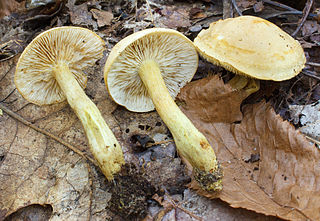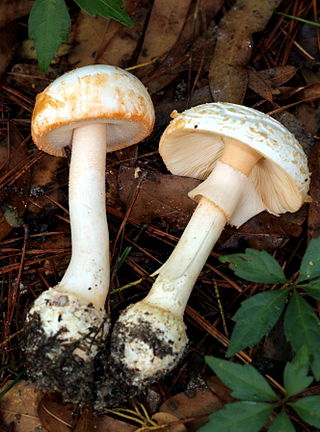
Lenzites is a widespread genus of wood-decay fungi in the family Polyporaceae. It was circumscribed by Elias Magnus Fries in 1835. The generic name honours German naturalist Harald Othmar Lenz (1798–1870).

Russula albidula is a species of mushroom in the genus Russula. The species, known in the vernacular as the boring white russula or the whitish brittlegill, is nondescript, with a small or medium dirty white fruit body, and a highly acrid taste. It is found in eastern North America.
Tricholosporum pseudosordidum is a species of fungus in the family Tricholomataceae. It is known from Florida.
Tricholoma venenatum is a mushroom of the agaric genus Tricholoma. It was first described scientifically by American mycologist George F. Atkinson in 1908.

Tricholoma myomyces is a mushroom of the agaric genus Tricholoma, usually considered to be a synonym of Tricholoma terreum. The species was first described scientifically by Christian Hendrik Persoon in 1794 as Agaricus myomyces, and later transferred to the genus Tricholoma by Danish mycologist Jakob Emanuel Lange in 1933. It is found in Europe and northern North America.

Tricholoma cingulatum is a mushroom of the agaric genus Tricholoma. First described in 1830 as Agaricus cingulatus by Elias Magnus Fries, it was transferred to the genus Tricholoma by Almfelt in 1830.

Tricholoma davisiae is a mushroom of the agaric genus Tricholoma. It was first formally described by Charles Horton Peck in 1900.

Tricholoma dryophilum is a mushroom of the agaric genus Tricholoma. First described as a member of the genus Melanoleuca by William Alphonso Murrill in 1913, he transferred it to Tricholoma later that year. It is toxic.
Tricholoma farinaceum is a mushroom of the agaric genus Tricholoma.

Tricholoma floridanum is a mushroom of the agaric genus Tricholoma. It was first formally described by William Alphonso Murrill in 1945.

Tricholoma fumosoluteum is a mushroom of the agaric genus Tricholoma. First described by Charles Horton Peck in 1875 as Agaricus fumosoluteus, it was transferred to the genus Tricholoma by Pier Andrea Saccardo in 1887.

Tricholoma intermedium is a mushroom of the agaric genus Tricholoma. It was formally described by American mycologist Charles Horton Peck in 1888.

Tricholoma niveipes is a mushroom of the agaric genus Tricholoma. It was formally described as new to science by American mycologist Charles Horton Peck in 1901.

Tricholoma odorum is a mushroom of the agaric genus Tricholoma. It was formally described in 1898 by American mycologist Charles Horton Peck. It is considered inedible.
Tricholoma acre is a mushroom of the agaric genus Tricholoma. The fruit bodies have light gray caps and stems, light grey gills, and an acrid taste.

Tricholoma subluteum is a mushroom of the agaric genus Tricholoma. Found in North America, it was described in 1904 by Charles Horton Peck.

Limacella glischra is a mushroom species in the family Amanitaceae. It was first named as a species of Lepiota by Andrew Price Morgan in 1906; William Alphonso Murrill transferred it to Limacella in 1914.

Amanita roseotincta is a species of agaric fungus in the family Amanitaceae found in North America. It was first described by American mycologist William Alphonso Murrill in 1914 as a species of Venenarius before being transferred to Amanita the same year.

Tricholoma roseoacerbum is an agaric fungus of the genus Tricholoma. The species was first described by Italian mycologist Alfredo Riva in 1979 as Tricholoma pseudoimbricatum var. roseobrunneum, but that name competed with an older homonym, William Murrill's 1913 Tricholoma roseobrunneum. Riva published the species with a new replacement name in 1984. T. roseoacerbum is found in Europe and northeastern North America. The specific epithet roseoacerbum alludes to the rosy colouration in its cap, and overall resemblance to T. acerbum. This species is probably conspecific with Tricholoma radotinense Pilát & Charvát (1959).















